Sorrel, Wood Sorrel, Suring, Indian Sorrel - Oxalis species
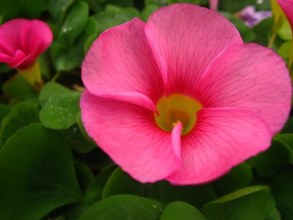 Oxalis obtusa Oxalis is the largest genus in the wood-sorrel family Oxalidaceae with about 800 species of both annuals and perennials which occur mainly in the tropical but also in the temperate regions of both the New and Old World. The richest diversity of species is found in tropical Brazil, Mexico and South Africa. Oxalis is the seventh largest genus (group of related species) in the Cape Floral Region of South Africa, with about 270 species occurring in southern Africa; mainly confined to Namibia and the Western and Eastern Cape. There is a rich diversity in the winter rainfall Fynbos Biome, but species are also found in the summer rainfall Savanna and Grassland Biomes. Oxalis grows in varied habitats, on sandy or clayey soils; in forests, moist areas, wetlands and alongside watercourses. It is often found along roadsides and on disturbed ground, as well as on rocky hillsides.
Oxalis obtusa Oxalis is the largest genus in the wood-sorrel family Oxalidaceae with about 800 species of both annuals and perennials which occur mainly in the tropical but also in the temperate regions of both the New and Old World. The richest diversity of species is found in tropical Brazil, Mexico and South Africa. Oxalis is the seventh largest genus (group of related species) in the Cape Floral Region of South Africa, with about 270 species occurring in southern Africa; mainly confined to Namibia and the Western and Eastern Cape. There is a rich diversity in the winter rainfall Fynbos Biome, but species are also found in the summer rainfall Savanna and Grassland Biomes. Oxalis grows in varied habitats, on sandy or clayey soils; in forests, moist areas, wetlands and alongside watercourses. It is often found along roadsides and on disturbed ground, as well as on rocky hillsides.
The plants contain oxalic acid and "Oxalis" originates from the Greek word "oxys" ,meaning sharp, acid or sour; referring to the characteristic sour taste of the leaves and flowers. The taste is reminiscent of the herb sorrel (Rumex acetosa); making them refreshing to chew and giving rise to the common name "wood sorrel".
Our indigenous species flower profusely over many months in winter, spring or summer, depending on the variety; and are available in colours ranging from red to pale and bright pink, lilac-pink, purple, mauve, salmon, orange, yellow, cream and pure white. Each flower has a yellow throat and five petals which flare like a trumpet during the day and furl at night or on overcast days. The very small fruits explode to disperse the tiny seeds far and wide.
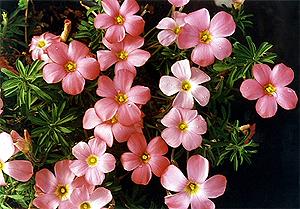 Oxalis hirta Picture courtesy Telos Rare BulbsSadly, our indigenous species often confused with exotic species like creeping sorrel (Oxalis corniculata) from North America and red garden sorrel (Oxalis latifolia) from Mexico; which have become common garden weeds in South Africa. Our indigenous Oxalis species make superb low-maintenance garden plants; Cape species are very showy and come in a wide range of flower colours and leaf forms; depending on the species, they will flower from late summer to winter, and into spring; putting on a spectacular splash of colour. The winter-growing species go totally dormant during the dry summer months; making them great water-wise plants for the winter rainfall regions.
Oxalis hirta Picture courtesy Telos Rare BulbsSadly, our indigenous species often confused with exotic species like creeping sorrel (Oxalis corniculata) from North America and red garden sorrel (Oxalis latifolia) from Mexico; which have become common garden weeds in South Africa. Our indigenous Oxalis species make superb low-maintenance garden plants; Cape species are very showy and come in a wide range of flower colours and leaf forms; depending on the species, they will flower from late summer to winter, and into spring; putting on a spectacular splash of colour. The winter-growing species go totally dormant during the dry summer months; making them great water-wise plants for the winter rainfall regions.
The new shoots emerge from dormant bulbs after the first good autumn rains and will usually stay active until early summer (November). In these regions a regular lawn can be transformed into a dazzling carpet of pink and mauve with minimal effort, by planting oxalis in the lawn. Oxalis purpurea often occurs in lawns and should not be confused with clover weed (Trifolium pretense). Oxalis makes nice neat mounds of leaves and is perfect to grow in pots or as seasonal groundcovers and edging plants. They look at their best when planted in groups and can be incorporated into garden beds, rockeries, and even between paving stones. They are tough and will survive quite happily without any additional water.
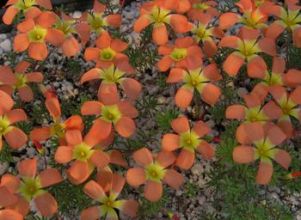 Oxalis massoniana Picture courtesy Telos Rare BulbsWood sorrel is an edible wild plant that has been consumed by humans around the world for millennia. In South Africa the sour leaves of Oxalis pes-caprae are an essential ingredient of waterblommetjie stew, and the bulbs of a number of species are eaten traditionally, but only after they have been dried or roasted. In India, creeping wood sorrel (Oxalis. corniculata) is eaten seasonally; and the tubers of Oxalis tuberosa have long been cultivated for food in Colombia and elsewhere in the northern Andes Mountains of South America. The Kiowa Indian tribe chewed wood sorrel to alleviate thirst on long trips, the Cherokee ate it to alleviate a sore throat, and the Iroquois ate wood sorrel to help with cramps, fever and nausea. Oxalic acid is present in many commonly consumed foods such as spinach, broccoli and Brussels sprouts, but in extremely large amounts it may be slightly toxic, interfering with proper digestion and kidney function.
Oxalis massoniana Picture courtesy Telos Rare BulbsWood sorrel is an edible wild plant that has been consumed by humans around the world for millennia. In South Africa the sour leaves of Oxalis pes-caprae are an essential ingredient of waterblommetjie stew, and the bulbs of a number of species are eaten traditionally, but only after they have been dried or roasted. In India, creeping wood sorrel (Oxalis. corniculata) is eaten seasonally; and the tubers of Oxalis tuberosa have long been cultivated for food in Colombia and elsewhere in the northern Andes Mountains of South America. The Kiowa Indian tribe chewed wood sorrel to alleviate thirst on long trips, the Cherokee ate it to alleviate a sore throat, and the Iroquois ate wood sorrel to help with cramps, fever and nausea. Oxalic acid is present in many commonly consumed foods such as spinach, broccoli and Brussels sprouts, but in extremely large amounts it may be slightly toxic, interfering with proper digestion and kidney function.
Oxalis is easy-to-grow provided they get enough water; they generally enjoy full sun and good drainage, but there are species to suit any situation; full sun, semi-shade or complete shade, and virtually all soil types. Species vary in height from +-6 to 30cm tall and produce bulbs which are often buried deep underground and readily proliferate by producing smaller bulbils. Feed with slow release 3:1:5 organic fertiliser before flowering in April and May, and water during growing season for best results.
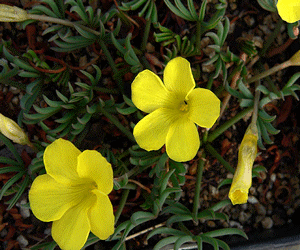 Oxalis flava Picture courtesy Telos Rare BulbsOxalis is propagated by their bulbs and by seed.
Oxalis flava Picture courtesy Telos Rare BulbsOxalis is propagated by their bulbs and by seed.
(Oxalis purpurea) occurs from Namaqualand in the northwest to Port Elizabeth in the southeast, and puts on a magnificent show in mid-winter and spring. Although it often occurs in lawns it should not be confused with clover weed (Trifolium pretense)
(Oxalis purpurea 'Mauve') is a flat growing ground cover, forming carpets of huge mauve flowers. It enjoys a well drained sunny position.
(Oxalis purpurea 'Pink') is a clump forming sorrel that produces its large dark pink blooms flowers for months on end. It grows well in sun or light shade.
(Oxalis purpurea 'White') is a clump forming sorrel with pure white flowers for months on end. It grows well in sun or light shade.
(Oxalis glabra 'Pink') occurs naturally in the western Cape and provides a dazzling carpet of pink flowers in late winter making it a very rewarding addition to any garden. It will grow happily in full sun or semi-shade.
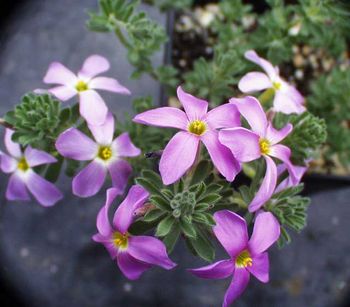 Oxalis hirta 'Lavender Form' Picture courtesy Telos Rare Bulbs(Oxalis glabra 'White') provides a dazzling carpet of white flowers in late winter making it a very rewarding addition to any garden. It will grow happily in full sun or semi-shade.
Oxalis hirta 'Lavender Form' Picture courtesy Telos Rare Bulbs(Oxalis glabra 'White') provides a dazzling carpet of white flowers in late winter making it a very rewarding addition to any garden. It will grow happily in full sun or semi-shade.
(Oxalis hirta) there are several forms of this beautiful Oxalis; occuring in the western and southwestern Cape. It is a vigorous growing species with long trailing stems and hairy leaves; producing masses of lovely magenta flowers. It enjoys full sun or light shade.
(Oxalis hirta 'Gothenburg') occurs naturally in south-west South Africa, from the Bokkeveld Mountains south to the Cape Peninsula. It grows +-30cm tall and in autumn and early winter produces beautiful flowers in shades of deep magenta-red to violet, purple or rarely white.
(Oxalis obtusa) is common and widespread and can be found growing on sandy or clay soils from Namaqualand to Knysna. It grows +-10 cm and has hairy or hairless leaves of three; the leaves are different shapes and sizes. The beautiful flowers come in many wonderful colours, from shades of pink, and peach to apricot and orange, brick red, yellow, white, and multi-coloured.
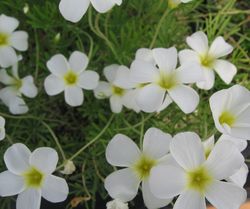 Oxalis cathara Picture courtesy Telos Rare Bulbs(Oxalis massoniana) is endemic to the Bokkeveld Escarpment, north of Nieuwoudtville, in the Northern Cape; meaning that it occurs nowhere else in the world. Sadly this beautiful little Oxalis is listed on the Red List of South African Plants. 8O% of its habitat has been transformed for wheat production and only two known locations are known where it still survives in the wild.
Oxalis cathara Picture courtesy Telos Rare Bulbs(Oxalis massoniana) is endemic to the Bokkeveld Escarpment, north of Nieuwoudtville, in the Northern Cape; meaning that it occurs nowhere else in the world. Sadly this beautiful little Oxalis is listed on the Red List of South African Plants. 8O% of its habitat has been transformed for wheat production and only two known locations are known where it still survives in the wild.
(Oxalis flava) Dikvingersuring occurs naturally from the Cape Peninsula to the eastern and northern Cape. It is an attractive plant with unusual hand-shaped grey-green leaves, which produces bright, butter-yellow flowers in spring and summer. It makes a wonderful tough groundcover, and is ideal for rockeries, corners and borders.
(Oxalis cathara) is a rare species from a restricted area of Namaqualand in South Africa, behaves the same way, and has a strong sweet scent.
WARNING: Although Oxalis pes-carpae and other plants containing soluble oxalic acid are not really poisonous, they can lead to animal fatalities if excessive amounts are consumed. In southern Africa and in many other parts of the world, outbreaks of oxalate poisoning have been reported, resulting from pastures infested with Oxalis or Rumex species. Sheep are mostly affected, but cattle and horses may suffer from degenerative conditions of the bones after prolonged exposure to low levels of oxalates'.
Mondo Grass, Lilyturf - Ophiopogon
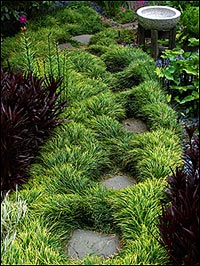 Mondo Grass. Picture courtesy www.acemondo.co.nzDescription, History & Interesting Facts:
Mondo Grass. Picture courtesy www.acemondo.co.nzDescription, History & Interesting Facts:
Ophiopogon is a member of the lily family and is native to the shady forests and woodlands of Japan and Korea, thriving in moist soils and alongside streams. It is a clump-forming evergreen perennial which is grown for its carpet of leaves which ripple in the wind; adding a whole other dimension to your garden.
Depending on the variety, the slender leaves grow from 5 to 40cm long and curve back toward the ground, resembling blades of turf grass. The plants spread via a network of rhizomes that grow just below the soil surface, and with age the clumps will merge to form a soft dense carpet. In spring tiny inconspicuous white to lilac flowers are produced amongst the leaves; followed by small bright blue berries.
There are several species of Ophiopogon, with dwarf cultivars available which have shorter leaves and form more compact mounds.
(Ophiopogon japonicus) has fine dark green leaves and spikes of white flowers; it grows +-30cm tall and 30cm wide.
(Ophiopogon japonicus 'Kyoto Dwarf') is a miniature which spreads to form a dense carpet of dark green leaves +-8 to 10cm tall, with spikes of lilac flowers.
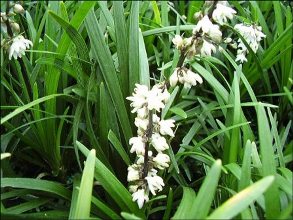 Ophiopogon planiscapus. Picture courtesy www.acemondo.co.nz(Ophiopogon japonicus 'Kyoto' Super Dwarf) only grows +-5cm tall and has short dark green leaves and tiny white flowers hidden within the foliage.
Ophiopogon planiscapus. Picture courtesy www.acemondo.co.nz(Ophiopogon japonicus 'Kyoto' Super Dwarf) only grows +-5cm tall and has short dark green leaves and tiny white flowers hidden within the foliage.
(Ophiopogon planiscapus) has clumps of dark green strappy foliage with small sprays of lilac or white flowers; iIt grows +-30cm tall.
(Ophiopogon planiscapus 'Nigrescens') is a dwarf cultivar +- 5 to 10cm tall with black leaves; making an excellent contrast plant in the garden.
(Ophiopogon planiscapus 'Black Dragon') has distinctive deep purple-black foliage and sprays of lilac-pink flowers. It is slow growing to a height of +-30cm.
(Ophiopogon japonicus 'Silver Mist') has narrow dark green leaves with fine white variegations, and pale lavender flowers; iIt grows + 25cm tall.
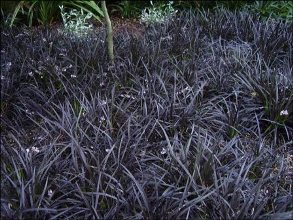 Ophiopogon planiscapus 'Black Dragon'. Picture courtesy www.acemondo.co.nz (Ophiopogon intermedians 'Alba Variegata') has completely white leaves when grown in the sun, but when grown in the shade it produces attractive green leaves with a white edge; it grows to a height of +-30cm.
Ophiopogon planiscapus 'Black Dragon'. Picture courtesy www.acemondo.co.nz (Ophiopogon intermedians 'Alba Variegata') has completely white leaves when grown in the sun, but when grown in the shade it produces attractive green leaves with a white edge; it grows to a height of +-30cm.
(Ophiopogon jaburan 'Vittatus') has green leaves with a vertical white stripe and small white flowers; it grows +-30 to 40cm tall.
In the Garden:
These versatile little plants are excellent to plant in bog gardens or in moist soil next to water features and alongside streams and dams. 'Kyoto Dwarf' is a great groundcover and good for edging walkways and defining beds. Tall varieties are often planted next to the foundations of buildings to help disguise and soften them.
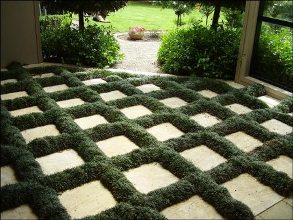 Ophiopogon japonicus 'Nana' Picture courtesy www.acemondo.co.nzIf the dwarf cultivars like 'Kyoto Dwarf' are planted thickly they make an excellent maintenance free lawn substitute for small gardens, requiring no mowing; and are especially useful to plant on slopes because the dense mat of roots holds the ground exceedingly well, preventing water runoff.
Ophiopogon japonicus 'Nana' Picture courtesy www.acemondo.co.nzIf the dwarf cultivars like 'Kyoto Dwarf' are planted thickly they make an excellent maintenance free lawn substitute for small gardens, requiring no mowing; and are especially useful to plant on slopes because the dense mat of roots holds the ground exceedingly well, preventing water runoff.
Dwarf varieties are also excellent planted between paving slabs and stepping stones, and are used extensively in Japanese pebble gardens; they also make a pretty edging plant for woodland and cottage gardens; geometric layouts, and in post modern and tropical schemes.
Ophiopogon with its finely textured foliage provides a handsome backdrop for more colourful plants, making it a useful evergreen for mixed planters of seasonal annuals or perennials.
Cultivation/Propagation:
Ophiopogon is virtually pest free and low-maintenance, making it a great choice for busy gardeners. It grows easily 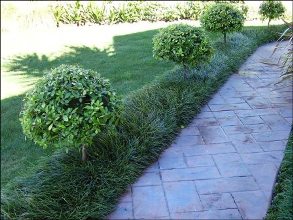 Ophiopogon japonicus. Picture courtesy www.acemondo.co.nzthroughout the country and is hardy to frost; it will struggle in very hot dry regions unless it can be watered regularly and is planted in semi-shade.
Ophiopogon japonicus. Picture courtesy www.acemondo.co.nzthroughout the country and is hardy to frost; it will struggle in very hot dry regions unless it can be watered regularly and is planted in semi-shade.
It thrives in moist soils and responds well to regular watering in the garden. It will grow happily in full sun or semi-shade and although it prefers light (sandy) to medium (loamy) soils, will adapt to most well-drained soils, including clay.
Divide the clumps every 2 to 3 years in early spring or autumn.
Ophiopogon is very easy to propagate by lifting and dividing the clumps, or by removing the rooted side shoots.
Renoster arctotis, Renostergousblom - Arctotis acaulis
 Arctotis - Picture courtesy Gunera - see flickr link
Arctotis - Picture courtesy Gunera - see flickr link Condensed Version:
Condensed Version:
Renoster Arctotis, Renostergousblom, Silver Arctotis, Witgousblom, Botterblom, Coast Arctotis, Kusgousblom, Namaqualand Arctotis, putswa-pududu, ubushwa (Arctotis)
Garden centres around South Africa sell a variety of arctotis with a great selection of colours and growth habits to brighten any space. The flowers come in shades of white, bright and light yellow, orange, red, pink, or mauve.
They are perfect for difficult seaside gardens and a great choice for water-wise landscapes and rock gardens. In large areas they make a glorious massed display or groundcover, and are often planted in pavement beds and traffic islands. Arctotis will quickly stabilise the soil on steep banks, and is stunning spilling over low retaining walls or down the sides of steps, and if planted into pots and window boxes will brighten up sunny courtyards and patios.
Refer to the species descriptions below for more detailed info on how to grow each one, but in a nutshell arctotis cope with a variety of harsh climatic conditions, as long as the soil drains well. They are perfect in coastal gardens, and in humid climates they require good air movement around the foliage. Arctotis do not thrive in mist-belt areas during the rainy months. They grow well inland if they can be protected from heavy frost, and in very cold regions they are often planted as summer annuals.
All arcotis love and thrive in full sun and in soil which has perfect drainage, be it acid or alkaline, granitic, sandy or clay soil. Although water-wise, in very hot and dry regions they will look at their best if they can be watered moderately.
In very impoverished soils, add compost when planting and mulch the soil to help retain moisture. Feed during the growing season with 2:3:2 for best results. Regular deadheading will dramatically extend the blooming period. To encourage the formation of new shoots, prune the trailing varieties back hard directly after flowering.
Established plants are available from your garden centre and seeds can also be sown. In the winter rainfall regions seed is sown in autumn and the seedlings are planted out just before the rainy season starts. In frosty gardens seed is sown in spring after all danger of frost is over. Sow into trays, or directly into garden beds. Cover the seeds lightly, keep them moist and they should start to germinate within a week.
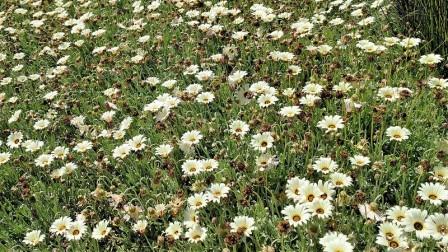 Arctotis stoechadifolia' Silver Arctotis' Picture courtesy K M - see flickr linkFull Version:
Arctotis stoechadifolia' Silver Arctotis' Picture courtesy K M - see flickr linkFull Version:
Description, History & Interesting Facts:
Many arctotis species make excellent garden plants and they are becoming more and more popular all over the world for their ease of growth and abundance of flowers through late winter, spring or summer, depending on the species chosen. Every year there are also more beautiful hybrids and selections available to gardeners. There are also a variety of forms, from clumping to spreading or trailing, and a gorgeous range of colours to suit every gardener’s palette.
Arctotis is an African genus of the daisy family (Asteraceae), with about 63 species occurring from the southernmost tip of South Africa to Angola. Most of the species occur in the Western and Eastern Cape, and Namaqualand, but Arctotis species are also represented in all the other provinces. The various growth forms include tufted annuals, perennial ground covers, small sprawling shrublets, and semi-woody shrubs. The flowers only open fully in bright sunlight, remaining closed in cold or rainy weather. They are visited by a variety of beetles and bees, any one of which could do the job of pollination. The seeds are light in weight and have a pappus of papery scales, which indicate that they are dispersed by wind.
Renoster Arctotis, Renoster Marigold, Renostergousblom, Tonteldoekblom (Arctotis acaulis)
The renoster arctotis is an easy to grow perennial, but is often best grown as a fast maturing annual. It grows +- 20 to 30cm tall with a basal tuft of hairy leaves which are a beautiful silver-grey. A dazzling display of flowers appear from late winter and spring to early summer (July to November), peaking in spring (August to October). In mild climates it can bloom for most of the year. It can be found growing in clay, limestone and granite soil in the renosterveld, fynbos, succulent karoo, and nama karoo biomes, from Calvinia in the western Karoo and the Bokkeveld Plateau to the Peninsula, and westward to Swellendam and the Langeberg Mountains.
Fabulous hybrids are available at garden centres, and the large, brightly coloured daisy flowers all have dark centres to show off the bright petals, which come in all shades of orange, yellow and red, as well as plum, pink and cream. There is also often an attractive black spot, or a black or bright yellow band at the base of the florets.
The renoster arctotis is excellent to control soil erosion at the coast and makes a most effective ground cover. It also looks wonderful spilling over low walls or a dry bank.
At Kirstenbosch seeds are sown in April to May to start flowering in late winter to spring and early summer (July to November), peaking in spring. In cold climates which experience frost, the seeds are sown in early spring for a summer display. Seed can be sown directly into prepared beds in full sun. Cover them lightly with soil and take care not to let the newly germinated seedlings dry out. Thin them out to space the seedlings +-20 to 25cm apart and water regularly. The plant can also be propagated by dividing the rootstock, which is used to preserve a particular type or colour form. Feed during the growing season with a balanced fertiliser and mulch the roots annually with well-rotted compost.
Botterblom, putswa-pududu, ubushwa (Arctotis arctotoides)
The botterblom is a fast growing groundcover which can spread up to 60cm wide and has long, light green leaves with wavy edges, and lovely felted, white undersides. The single butter-yellow flowers are borne on 20cm long stems almost all year round, peaking in winter (June to August), and complementing the many aloes which bloom at the same time. It is widespread throughout the summer rainfall areas of South Africa and Lesotho, where it favours disturbed areas like the verges of roads.
In the garden it grows and flowers best in full sun, and tolerates most soil types, from sand to clay, and well-drained as well as marshy areas.
Although this groundcover can look a bit ‘weedy’, it is such a tough plant with such an abundance of flowers that it definitely deserves a place in the garden. It is invaluable in aloe gardens as it blooms at the same time, and is great in informal plantings, along the edges of paths, and even in rockeries. Because it will also grow in marshy areas, use it around dams or water features in full sun. The plants grow very fast and tend to get untidy after 3 to 4 years, when it is best to replace them. In summer, Arctotis arctotoides makes a very pretty combination if it is mixed with the beautiful blue Cape-forget me-not (Anchusa capensis). Click here to see pictures at PlantZAfrica
Trailing Arctotis, Silver Arctotis, Witgousblom, Coast Arctotis, Kusgousblom, Bittergousblom (Arctotis stoechadifolia)
Arctotis stoechadifolia is a very vigorous sprawling perennial which hugs the ground closely and roots continuously as it spreads. The white felted leaves are long and narrow with slightly toothed or serrated edges, providing a striking silver-grey carpet. The masses of showy flowers appear from spring to summer (September to December), standing on upright shoots about 35cm tall. They are a creamy light to bright yellow, marked with maroon underneath, and the centre of the flower is black. The stems and leaves are slightly sticky with a very strong bitter-sweet smell when touched.
The trailing arctotis occurs naturally only on the dunes and sandy flats along the coast from Langebaan to the Cape Peninsula. In its range it is quite common and very vigorous, with beautiful spring displays along the coastal strip between Bloubergstrand and Melkbosstrand. It is very adaptable and manages to thrive in harsh, sandy, coastal conditions, with hot dry summers, strong winds, salt spray, and low winter rainfall (500mm or less in this area).
In coastal gardens this is one of the best groundcovers to retain the sand cover, and is very striking if allowed to cascade down a stone wall.
Arctotis stoechadifolia became a problem plant in California and Southern Australia, where it was used as a coastal sand-stabilizing plant but quickly became a weed, escaping cultivation and invading indigenous areas. Bear this in mind if you plant it in warm, moist regions of South Africa.
The trailing arctotis performs well in almost any soil with good drainage, is resistant to salt-laden wind, and water-wise. It must be planted in full sun and is adapted to the Mediterranean climate of the Cape, where it can survive with very little water in summer. Inland, the plants need to be watered in winter and in cold regions they will need protection from frost, but should re-sprout in spring after frost damage, if the roots are thickly mulched in winter.
In the winter rainfall regions seeds should be sown in seedling trays during autumn and planted into small pots to be grown on. Plant out as soon as they are big enough to handle. In cold gardens, sow in spring after all danger of frost is over, or earlier into trays if you have a greenhouse. The plant can also be propagated by cuttings or by dividing the rootstock, which is used to preserve a particular type or colour form.
Namaqualand Arctotis, Namaqua Marigold, Double Namaqualand Daisy, Namakwagousblom, Bittergousblom (Arctotis fastuosa)
The Namaqualand arctotis is a frost hardy annual species from the dry Namaqualand region where the seeds lie dormant during the scorching hot summers, and opportunistically respond to good rains at any time of the year, but especially in late winter and spring (July to October). The green leaves are covered in white hairs and the flowers are born on long stalks, in various shades of orange, yellow and cream. The size of the plant will depend on rainfall but if it is watered moderately in the garden it can grow up to 60cm tall.
Of all beautiful annuals of Namaqualand, this is one of the easiest and most colourful for cultivation in gardens, and is the parent of a number of delightful hybrids that are popular for bedding displays, gravel gardens and containers. The flowers of these modern cultivars tend to stay open longer than the natural species, which only open on sunny days and close by mid-afternoon.
For a spring show sow the seeds in autumn, and for a summer display, sow the seeds in late September or early October, germination is within a week. Seeds can be sown in seedling trays or directly into well-prepared garden beds. Plant the seedlings about 10cm apart and weed regularly until they have filled out and covered the ground. Full sun is essential, as is well-drained soil. Watering regularly is important for success with the seedlings and plants in the garden. They also respond well to feeding with an organic fertiliser.
 Arctotis acaulis' Purple' Picture courtesy K M - see flickr linkUses:
Arctotis acaulis' Purple' Picture courtesy K M - see flickr linkUses:
The rural people of Eastern Cape are known to use Arctotis arctotoides for the treatment of epilepsy, indigestion and catarrh of the stomach, and the leaf juice or a paste of the leaf is applied topically to treat wounds. Studies have shown that an extract of the leaf does have anti-bacterial properties.
In earlier times, the grey felt on the undersides of the leaves of many species in the daisy family, including Arctotis acaulis, was scraped off and used as tinder (tontel). When scraped off this felt resembles a miniature cloth (doek), which is where this species gets its Afrikaans common name, “tonteldoekblom”.
In the Garden:
Garden centres around South Africa sell a variety of arctotis with a great selection of colours and growth habits to brighten any space. The flowers come in shades of white, bright and light yellow, orange, red, pink, or mauve, so pay them a visit when they are in full bloom to make your selection.
They are perfect for difficult seaside gardens and a great choice for water-wise landscapes and rock gardens. In large areas they make a glorious massed display or groundcover, and are often planted in pavement beds and traffic islands. Arctotis will quickly stabilise the soil on steep banks, and is stunning spilling over low retaining walls or down the sides of steps, and if planted into pots and window boxes will brighten up sunny courtyards and patios.
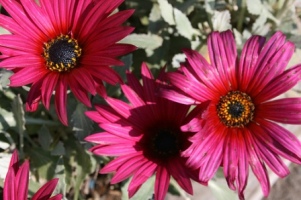 Arctotis acaulis 'Pink' Picture courtesy Green Acres Nursery CaliforniaCultivation/Propagation:
Arctotis acaulis 'Pink' Picture courtesy Green Acres Nursery CaliforniaCultivation/Propagation:
Refer to the species descriptions above for more detailed info on each one, but in a nutshell arctotis cope with a variety of harsh climatic conditions, as long as the soil drains well. They are perfect in coastal gardens, and in humid climates they require good air movement around the foliage. Arctotis do not thrive in mist-belt areas during the rainy months. They grow well inland if they can be protected from heavy frost, and in very cold regions they are often planted as summer annuals.
All arcotis love and thrive in full sun and in soil which has perfect drainage, be it acid or alkaline, granitic, sandy or clay soil. Although water-wise, in very hot and dry regions they will look at their best if they can be watered moderately.
In very impoverished soils, add compost when planting and mulch the soil to help retain moisture. Feed during the growing season with 2:3:2 for best results. Regular deadheading will dramatically extend the blooming period. To encourage the formation of new shoots, prune the trailing varieties back hard directly after flowering.
Established plants are available from your garden centre and seeds can also be sown. In the winter rainfall regions seed is sown in autumn and the seedlings are planted out just before the rainy season starts.
In frosty gardens seed is sown in spring after all danger of frost is over. Sow into trays, or directly into garden beds. Cover the seeds lightly, keep them moist and they should start to germinate within a week.
 Arctotis 'Pumpkin Pie' Problems, Pests & Diseases:
Arctotis 'Pumpkin Pie' Problems, Pests & Diseases:
Black, hairy worms attack plants in the garden and nursery, but it is not necessary to spray as they seldom do serious damage and the tough plants re-sprout again vigorously.
Warning:
Although Arctotis is listed as safe, if you suspect that a child or pet has eaten quantities of any of these plants, or if you notice symptoms such as illness or dermatitis after handling these plants, call your doctor or veterinarian for advice.
Beggar's Tick - Bidens ferulifolia
Wild Sweet William - Phlox divaricata
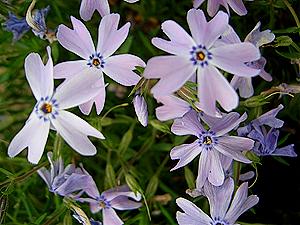 Phlox divurcata This charming groundcover is another plant that is no longer easy to find in South Africa, however, because many old gardens and parks still have it growing, I have left it here for identification purposes. If you do find some and want to propagate them, they are easily divided.
Phlox divurcata This charming groundcover is another plant that is no longer easy to find in South Africa, however, because many old gardens and parks still have it growing, I have left it here for identification purposes. If you do find some and want to propagate them, they are easily divided.
This creeping little plant from eastern and northern America is grown for its abundance of pale blue flowers in spring and early summer, and spreads +-25cm tall and +-35cm wide.
Plant it as a border in the flower garden, in rockeries and pebble gardens, or as a groundcover.
Phlox are evergreen perennial plants that grow best in moist, temperate areas, but are hardy to frost. They are not suited to very hot, humid regions.
They need very rich, well-drained soil and must be watered regularly in summer, especially in hotter areas and in the winter rainfall regions. If they are watered regularly, they will also spread quickly.
Plant them in sun or semi-shade and remove dead flowers heads regularly.
They can be lifted and divided in autumn.
Moss Pink - Phlox subulata
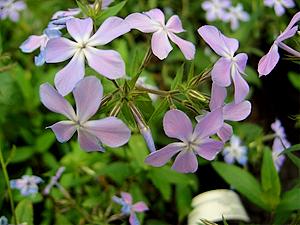 Phlox subulataThis lovely little flowering groundcover is no longer easy to find in South Africa, but I have left it here for identification purposes as some older gardens and parks still have it growing, and certain nurseries may still sell it.
Phlox subulataThis lovely little flowering groundcover is no longer easy to find in South Africa, but I have left it here for identification purposes as some older gardens and parks still have it growing, and certain nurseries may still sell it.
This creeping little plant from the eastern U.S.A. is grown for its abundance of rose pink, purple, blue and white flowers, for a long time in spring and early summer. Plant it as a border to the flower garden, in rockeries and pebble gardens, or en masse as a groundcover.
Phlox are evergreen perennials that grow best in moist, temperate regions, but are hardy to frost.
They need very rich, well-drained soil and must be watered regularly in summer, especially in hotter regions, and in the winter rainfall regions. They are not suited to very hot, humid regions.
Plant them in full sun and remove dead flowers heads regularly.
They can be lifted and divided in autumn. If they are watered regularly, they will spread quickly to +-25cm tall and +-40cm wide.
Star Jasmine - Trachelospermum jasminoides
Australian Violet - Viola hederacea
Condensed Version:
The Australian violet is a delightful spreading evergreen groundcover which forms mats of bright green leaves, and masses of tiny white and violet flowers in spring, summer and autumn, and in warmer subtropical gardens it can flower all year round. The flowers stand above the foliage, at a height of about 15cm, and each plant can spread via underground runners to about 30cm. Although these plants grow well in shaded conditions like forests or anywhere under heavy tree cover, they do need sunshine to flower well.
The Australian violet grows throughout South Africa, and is a very low maintenance plant that can thrive with very little care and attention if planted in the right areas. Although it grows in sheltered positions in coastal gardens, it will not tolerate direct coastal exposure and salty winds. If the soil is kept moist it thrives in the heat, tolerating temperatures as high as the mid 40's°C. It is also hardy to moderate frost and can tolerate temperatures as low as -5°C for short periods. In severely cold regions the leaves may go dormant in winter, but if the roots are thickly mulched the plant will willingly shoot again in spring. In the winter rainfall regions, and other hot and dry regions, it will require summer watering.
In most regions of South Africa it will grow happily in semi-shade to full sun, as long as it can be watered regularly. In fact the plant flowers more abundantly where it receives more sunshine, and in very deep shade flowering will be inhibited. However, in very hot and arid regions semi-shade is always best.
Besides being very sensitive to salinity, it adapts to most garden soils, and can be grown in slightly acidic to slightly alkaline soils. To give your plants a good start, dig the beds over well, incorporating compost and a dusting of bone meal or superphosphate, and plant about 30cm apart for a groundcover. For the best results, water moderately during the growing season, and the plants can be fertilised along with the rest of the garden in summer.
Full Version:
Description, History & Interesting Facts:
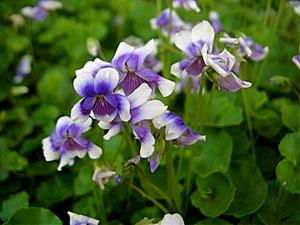 Viola hederacea is a part of the Violaceae family and is one of the 400 species of violets found worldwide. It is commonly known as the Australian or Tasmanian violet, or in Afrikaans Viooltjie. The word “hederacea” comes from the Latin phrase meaning “like ivy,” which describes the ivy-like leaves of this this trailing ground cover.
Viola hederacea is a part of the Violaceae family and is one of the 400 species of violets found worldwide. It is commonly known as the Australian or Tasmanian violet, or in Afrikaans Viooltjie. The word “hederacea” comes from the Latin phrase meaning “like ivy,” which describes the ivy-like leaves of this this trailing ground cover.
This species of violet is native to eastern Australia, where it is widespread, and in nature it can be found growing in the shade of forests, or trailing artistically down the sides of waterfalls, or forming a blanketing groundcover around small bodies of water, or any other place where they can find moist and rich soil for them to spread via their underground runners.
The Australian violet is a delightful spreading evergreen which forms mats of bright green leaves and masses of tiny white and violet flowers in spring, summer and autumn, and in warmer subtropical gardens it can flower all year round. The flowers stand above the foliage, at a height of about 15cm, and each plant can spread via underground runners to about 30cm. Although these plants grow well in shaded conditions like forests or anywhere under heavy tree cover, they do need sunshine to flower well and will be more prolific in more sunshine.
Click here to see Google images of Viola hederacea
In the Garden & Home:
The Australian violet is an excellent fast spreading perennial groundcover for moist, shady areas, growing well under a canopy of trees. However, it also takes full sun if watered regularly, making this little plant excellent in beds where the shade pattern varies greatly between summer and winter, for example, underneath deciduous trees which allow the full sun through in winter but are shaded in summer.
It is good to stabilise the soil on banks and perfect next to water features, rivers, ponds or dams. It is essential in all woodland and cottage gardens, where it forms a pretty groundcover amongst other flowers, or in the rose garden.
It is lovely planted between pavers, stepping stones and alongside pathways. And in areas where grass struggles to grow, this plant can be a beautiful alternative. The Australian violet is quite hardy and can tolerate being minimally walked upon by humans or animals, so long as they aren’t regularly trampled.
Its lovely trailing habit makes this violet a wonderful addition to mixed container plantings and hanging baskets.
Australian violet flowers can be used as garnish, and in salads, and as they don’t have a strong taste, they can be used with sweet or savoury foods. Enjoy their delicate beauty as a finishing touch on small cakes, or if you have plenty, add them to a spring salad. You can also add the fresh, small green leaves to your salad, as they’re also edible. Flowers are fairly prolific from spring to autumn, so these are a handy flower to have in your garden if you like to use edible flowers.
 Cultivation/Propagation:
Cultivation/Propagation:
The Australian violet grows throughout South Africa, and is a very low maintenance plant that can thrive with very little care and attention if planted in the right areas. Although it grows in sheltered positions in coastal gardens, it will not tolerate direct coastal exposure and salty winds. If the soil is kept moist it thrives in the heat, tolerating temperatures as high as the mid 40's°C. It is also hardy to moderate frost and can tolerate temperatures as low as -5°C for short periods. In severely cold regions the leaves may go dormant in winter, but if the roots are thickly mulched the plant will willingly shoot again in spring. In the winter rainfall regions, and other hot and dry regions, it will require summer watering.
Although, in its natural habitat it thrives in moist shady places, in most regions of South Africa it will grow happily in full sun, as long as it can be watered regularly. In fact the plant flowers more abundantly where it receives more sunshine, and in very deep shade flowering will be inhibited. However, in very hot and arid regions semi-shade is always best.
Besides being very sensitive to salinity, it adapts to most garden soils, and can be grown in slightly acidic to slightly alkaline soils. It is adapted to chalk, clay loam, loam, loamy sand, sandy clay, sandy clay loam and sandy loam soils. To give your plants a good start, dig the beds over well, incorporating compost and a dusting of bone meal or superphosphate, and plant about 30cm apart for a groundcover.
For the best results, water moderately during the growing season, and the plants can be fertilised along with the rest of the garden in summer.
The Australian violet grows moderately fast and is usually not invasive, but under favourable conditions it can become invasive, but it is easy to control if necessary.
Propagation is by division of the runners in autumn - simply dig up a section of plant with roots attached and replant where you want them.
 Problems, Pests & Diseases:
Problems, Pests & Diseases:
Slugs and snails also favour moist, shady areas and tend to feast on the leaves and stems of Australian violets. This is typically not a significant problem, but organic snail baits and snail traps can be used to control them if necessary. Also, look out for aphids which also love violas.
Warning:
The fresh, young flowers and leaves of Australian violets are edible.
However, seeds of many violets are considered toxic if ingested, although there is no concrete data on Australian violets in particular.